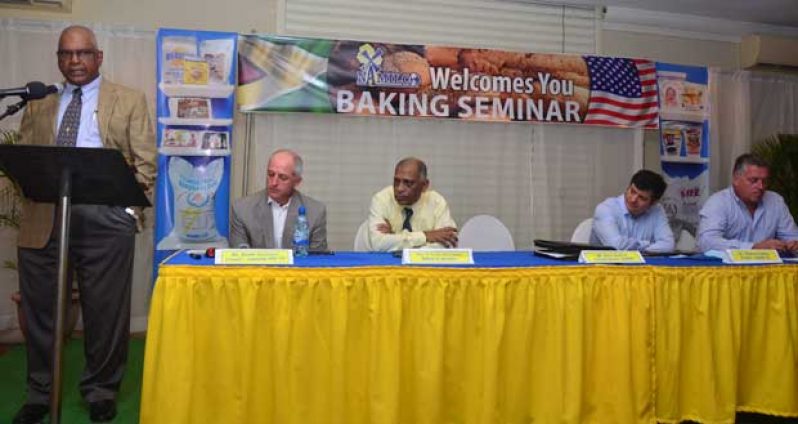–Managing Director tells it like it is
SADDLED with steep and fast growing production costs, 35% of which represent only electricity consumption, the National Milling Company of Guyana (NAMILCO) is considering purchasing a new mill, in order to be able to maintain a competitive edge in the flour milling business.
The ultimate decision in regard to purchase is really a $US10 Million (Gy$2 Billion) question, as that was the sum budgeted for a new mill.
NAMILCO’s Managing Director, Mr. Roopnarine (Bert) Sukhai, made this disclosure when he addressed the company’s Bakers’ Seminar at Parc Rayne, Ray Rahaman’s Park, East Bank Demerara last week.
The seminar was held under the theme: “Taking Guyana’s Bakeries to the next level.”
Outlining the complexities of the situation as regards operating on Guyana Power and Light’s (GPL) 50-cycle grid as against purchasing a new mill, Mr. Sukhai affirmed: “We need a new mill to have a competitive edge; and with the cost of electricity being over 35% of our production cost presently, what should we do?
“That is the US$10 million (G$2 billion) question, as that was the sum we have budgeted for a new mill. Should we keep our mill on 50 cycles indefinitely, or should we convert to 60 cycles but face the prospect of an unreliable and expensive power supply?” he pondered.
The Managing Director recalled that, a few years ago, GPL indicated that in order to stay on the grid, NAMILCO would have had to convert its plant from 50 to 60 cycles, and that deadlines were set.
“We recognized (that) to do so would entail a long downtime, which even with imports would have resulted in a shortage of flour and specialty flour products on the market; something we could all ill afford,” he said.
He said that talks regarding hydropower were ongoing at that time, and NAMILCO was optimistic. Thus, at the beginning of last year, NAMILCO took the decision to keep its mill on 50 cycles, using self-generation, and to start planning to build a new 60 cycle mill that would be using cheaper power supplied by the Amaila Falls Hydropower plant.
“Our projection was that the mill completion would have occurred at about the same time Hydro power came on stream in a few years. We are now off the grid, except for lights and air-conditioners; producing our own power, but with the prospect of hydropower getting dimmer,” Mr. Sukhai outlined.
That development dealt the company a devastating blow, since Namilco was in the process of preparing the plans for a new mill, but with the prospect of benefiting from an alternative source of power (hydro-power).
“With things having gone awry in the absence of hydro-power”, he reasoned, “we would now have to include in our plans new generating sets at 60 cycles to cater for the frequent power outages we will continue to suffer from.”
Mr Sukhai highlighted three such scenarios nationally, which he said would very likely affect businesses adversely, preventing them from engaging in long-term plans.
SECOND SCENARIO
The second scenario, one of major concern to NAMILCO, he pointed out, was the cost of buying the US dollar to pay for wheat, packaging, spares, and other raw materials.
“Up to around August 2013, we were paying Gy$204-Gy$206 for the US$. Today we are paying between Gy$210 and Gy$213 for that same dollar,” he said, adding, “This means that our local cost for wheat and other raw materials have risen steeply; a cost we will be forced to pass on, as we cannot bear it in the long term.”
In this regard, he questioned whether the non-passage of the Anti Money Laundering Bill is related to the cost of acquiring US currency, but said he would leave that to the experts.
Mr. Sukhai said he observed that the exchange rate kept climbing as the debate on the AML/CFT Bill continued, but he said he hoped that as Guyana stands to be sanctioned, acquiring US dollars would not become a hassle and result in delays in the payment for raw materials, as this can have serious repercussions.
THIRD MAJOR CONSTRAINT
The increasing cost of shipping and discharging wheat was also a major consideration. Mr. Sukhai said NAMILCO has to constantly dredge its wharf in order that vessels bringing wheat might moor.
“Larger vessels cannot enter the Demerara channel because of draft restrictions, so we have to use smaller vessels, where the freight per metric tonne is higher.”
These two factors, he said, send up NAMILCO’s cost of freight and discharge to as much as three times what it would cost to take wheat from the same source to other mills in CARICOM countries.
“These major disappointments are now our biggest constraints, as we have to balance the cost of a staple food item against the rising cost of producing it,” Mr Sukhai stated. He, however, added that NAMILCO will continue to do whatever it could to keep the price of flour affordable, and he assured the bakers and other stakeholders present that NAMILCO is always available to offer advice and assist in taking them to the next level in baking.
The seminar was declared open by Agriculture Minister Dr. Leslie Ramsammy, who also delivered the feature address. Others among the distinguished gathering were special guest presenters Messrs. Miguel Galdos and Keith Clemens.
Galdos is Regional Director Assistant for US Wheat Associates in South America. He has more than 10 years’ experience in the wheat/bread chain, and has travelled throughout Latin America, giving service. He is also Director of Galdos Consulting Ltd., a company that represents in Latin American, Research Products Company and Engrain.
An Agricultural Engineering graduate of Universidad Mayor in Santiago, Chile, Galdos is a presenter of services throughout the continent of South America.
Mr. Keith Clemens, Technical Services Manager at Seaboard Overseas Group, Missouri, USA, is a graduate of the American Institute of Baking, and of Baker University, a top-ranked University in Kansas, USA.
Mr. Clemens is attached to Seaboard Corporation (Namilco’s head office) and has more than 25 years of management, sales, and technical service experience in the Food and Baking Industries, covering South Africa, North America and the Caribbean.
Namilco is a subsidiary of Seaboard Corporation, which is based in Shawnee Mission, Kansas, USA, and the collaboration was in keeping with Namilco’s commitment and its ISO 2008 mandate to maintain its reputation for excellence in the services that it provides to its customers.
The theme for the Bakers’ Seminar was “Taking Guyana’s Bakeries to the Next Level”, in keeping with Namilco’s objective of assisting in the growth of Bakers’ business and the baking industry in Guyana as a whole.
Mr. Sukhai says Namilco was very pleased to host the Baking Seminar, and saw it as giving back to bakers in a meaningful way, while maintaining customer loyalty.
In fact, he alluded to Namilco as being ‘more than just flour’, stating that the company produces different types of flour, down to the popular and eagerly sought- after Pholourie Mix, which has split-peas added.
As current President of the Caribbean Millers’ Association, Mr. Sukhai expressed confidence that no other mill in the Caribbean has the variety of products that Namilco boasts.
Mamilco is an ISO 9001 certified company, and its team is dedicated to satisfying its customers.



.jpg)








